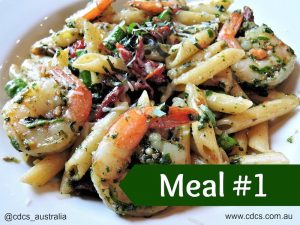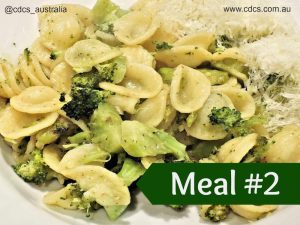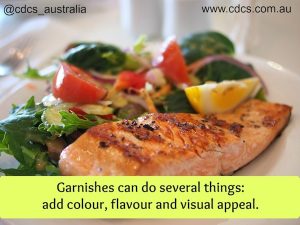The saying goes that we eat with our eyes first.
I’ll admit, I have been guilty of this – either deciding I don’t like something simply by looking at it or piling my plate with more food than I can eat (but sometimes it all looks so irresistible!). You’ve probably experienced something similar and I’m sure most people do – food presentation is an important factor in promoting appetite.
The fact is, most of us judge food by its appearance and react accordingly. Look at the two images below – which would you prefer?


Both are pasta dishes, but if I had to pick, I’d choose Meal #1. It is more appealing with its colour and variety and looks tastier than Meal #2. I could be completely wrong – Meal #2 might be the tastiest dish ever created, but because it doesn’t look as appealing, I’m less likely to try it.
Clients receiving delivered meals deserve a meal that is not only nutritious but also appealing. I have seen clients on community empty their container of food out for their dogs to eat because the meal was sloppy and unappealing. Their next stop is the local shop for a meat pie or fried chicken. Conversely, I have seen meals where the cook has taken great care in making sure the meal is presented nicely and observed clients eagerly consuming that food.
Your clients are your customers. Like all customers, they have the power to purchase from you or take their business elsewhere, especially Home Care Package clients from February 2017. The challenge is to encourage healthy eating habits whilst meeting individual dietary needs and personal preferences.
So here are some tips to keep in mind when cooking and presenting food that may entice clients to eat your healthy and nutritious meals.
Colour
Foods come in a variety of bright colours and we can definitely use this to create dishes that look appealing. Hints of green from garden peas or the cheerful orange colour of carrots or yellow corn can do a lot to brighten up a dull brown beef stew.
Texture
Make sure your food isn’t ‘boring’ when someone is eating it. Think of a classic roast beef dinner: you’ve got the slightly chewy consistency of the beef, the starchy thickness of the roast potatoes, the hint of crunchiness from the boiled carrots and the smooth heat of the rich gravy (is your mouth watering yet?). All those sensations add up to make the meal more enjoyable. Where clients require their food to be pureed, ensure that it is only processed to the texture modified level they require.
Temperature
Perhaps not one of the most obvious things you think about, but definitely important. After all, you’re unlikely to eat a beef stew when it’s cold and you wouldn’t eat ice cream after it had melted. Additionally, you also need to ensure that your meals are delivered to the person in a timely manner, avoiding the danger zones for bacterial growth. Also consider the unique requirements of the person receiving the meal; make sure the food is not too hot for a frail older person who may spill food and scald themselves.
Seasoning
Salt and pepper can enhance the flavours of your ingredients, however they can also completely destroy a meal if not used properly! I’m sure you’ve had something with too much salt or pepper in it at one point – not a good experience. Don't forget that there are other herbs and spices that can be used to enhance a meal and can replace or reduce the amount of salt for people who require a low salt diet – commonly used alternatives on community are garlic and curry powder.
 Garnish
Garnish
Okay, in the remote setting we don't often consider adding a garnish especially as most meals are home delivered in containers, but that doesn't mean you can't consider using a garnish when creating a special meal for clients to eat at the centre. Using garnishes is like decorating your food. The most common garnish is parsley – you’ve no doubt seen sprigs of the curly-leafed variety adorning many a dish, or chopped up and sprinkled over the top. It’s simple, but effective, brightening the food with that hint of fresh green. Garnishes don’t have to be herbs, though. What about the lemon wedge that often comes with fish dishes? The bright yellow colour contrasts with the plainer coloured fish and the accompanying green salad, that's great food presentation albeit a simple approach.
Companionship
Something often heard from older people is that they don't bother cooking or eating much because they can't be bothered cooking for just themselves. When older people have the opportunity to sit down and have a meal or a snack with others, they often find themselves eating more than they normally would consume if they were alone. Encourage clients to come to the aged care centre for their meals if you have the facility for this service, especially where there are concerns that the person is not eating enough or there are social pressures at home that impact on food security.
So have a look at the meals you are sending out to clients. Are they healthy and nutritious? Probably. Are they appealing to the eye and do they make the clients want to eat them? Maybe.
Ask your clients for feedback – what can you do to improve the meals offered or entice reluctant eaters?
- Aged Care Packages – what's in the box? - February 16, 2024
- 11 Ways to Make Your Progress Notes Better - September 22, 2023
- Vulnerable Clients – Who are they? - July 14, 2023
- Food Safety – Cooling and Reheating Food Safely - June 23, 2016
- 6 Simple Tips That Make Clients Want to Eat Their Meal - May 12, 2016
- Dishwashers – the truth and tips - June 4, 2015



